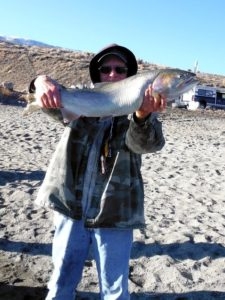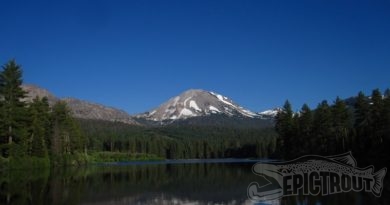Pyramid Shore
Late fall and winter can hit hard in Northern Nevada. High winds, temps down to zero and below, snow, wind, rain, hail. For most it’s time to put away the summer toys and huddle before the fire. For some it is a cause for celebration.
Pyramid Lake, Nevada lies approximately 40 miles north of Reno, Nevada. This large desert lake is just short of 30 miles long and 9 miles wide and is at an elevation of 3,800 feet ASL. The Maximum depth of Pyramid is 344 feet and the mean depth of 196 feet. Pyramid is the terminus of the Truckee River that flows generally northeast from Lake Tahoe. This large desert lake is the largest remnant of ancient Lake Lahontan that covered much of North Western Nevada at the end of the last great ice advance. Pyramid Lake is completely in closed within the 742 sq mi Pyramid Lake Indian Reservation and is administered by the Pyramid Lake Paiute tribe who set the rules for those who visit the reservation and fish the lake. A good way to think of Pyramid is Tahoe without the trees.
Though slightly salty and alkaline Pyramid Lake provides a good habitat for various fish and aquatic life. Native to the Lake are Lahontan Cutthroat Trout, Cui-ui, an endangered lake sucker, and Tui Chub. Introduced fish include Sacramento perch and Carp. In the summer anglers fish for Perch and Carp but it is the Lahontan Cutthroat Trout that attract fishermen form all over the United States and other parts of the world.
Fishing for Cutthroat is open From October 1 until the end of June. The fishing is artificial lures and flies only with barbless hooks. If you want to keep some there is a slot limit of 2 fish. You can keep 2 fish between 17 and 20 inches or one fish over 24 inches and one fish 17 to 20 inches,
How is this lake fished? A lake this size is obviously a prime target for boat fishermen. Both trolling and jigging are popular and quite rewarding. But this lake is somewhat different then most large waters. There is an excellent bite as well for those who fish the shore. LCT in Pyramid seem to be shore orientated and as a bonus the bigger the fish the more they hang in close.
Fly fishing from the shore or ladders or from personal water craft is rewarding. Pyramid is perhaps one of the top destinations of fly fishermen in the Western US. But there are other ways to to fish this shore.
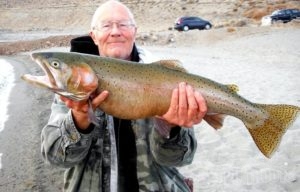
About Pyramid LCT: There are 13 different cutthroat trout subspecies in the American west. Of these the Lahontan Cutthroat Trout is the largest. Fish of over 60 pounds have been reported with a fish of 41 pounds caught by an angler in 1925 in Pyramid Lake.
By the 1940s the giants were gone, victims of over fishing, the damming and diversion of the Truckee River and the introduction of non native species into the Truckee River drainage. In the 50s and 60s various species of fish were introduced into the lake to try to revive the fishery including striped bass, kokanee salmon, Cutthroat X Rainbow hybrids and LCT from out of the drainage. The only success story was the introduction of Sacramento Perch.
In the mid 70s the Piute Tribe opened a hatchery on the lake that utilized fish from Summit Lake in Northern Nevada. Now the tribe stocks 600,000 to 1,000,000 LCT per year into Pyramid and the Lower Truckee. By any measure this is a resounding success. The fish grow large and healthy and draw anglers from across the country to do battle. But these are not the monsters that swam the waters of Pyramid in the early 20Th century.
In the late 1970s an isolated population of LCT near Pilot Peak in extreme Eastern Nevada and Western Utah was discovered. In the early 1900s a rancher was believed to have stocked a small stream with LCT fry taken from Pyramid Lake. Could these small stream cutthroat be the direct decedents of the Pyramid monsters? Specimens were taken and studied by biologists and fisheries professionals from universities and the USFWS. Finally geneticists recently compared cutthroats from the Pilot Peak stream with mounts of giant Pyramid Lake trout and discovered an exact DNA match. The Lahontan National Fish Hatchery in Gardnerville, Nevada started developing the strain and it was first stocked in Pyramid Lake in 2006. By 2012 15 pound plus Pilot Peak fish were falling to anglers. In the fall of 2012 a 24 pound fish was caught. The monsters were back.
What to use.

Spoons have always been popular at Pyramid. Usually they are big and colorful. 1/2 to 1 oz. are the sizes most popular. Sierra Spoons. Krockdiles, Kastmasters work well. They can be fished at any depth and off deep sandy bottoms.

Jigs are very effective at this lake. Tube jigs 1/2 oz or less. Marabou jigs, Lead head grubs. Even heavy metal jigs such a P-line or Crippled Herring. These are fished on the bottom in shallow to deep water on bottoms that are sandy or limited to pebbles. Smaller jigs can be fished below a bobber or strike indicator in rocky areas or when fish are feeding near the surface.
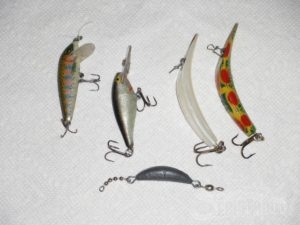
Hard Plastics: Many of the biggist fish come on these. 2 1/2 to 7 inch baits imitate food fish to the large Piscavorious Cutts. Various Rapalas, Rebels, Flat Fish, all work. These are usually fished around 5 feet behind a 1/2 to 1 oz banana sinker on the bottom. A slow retrieve with starts and stops to allow the lure to float up and dive.
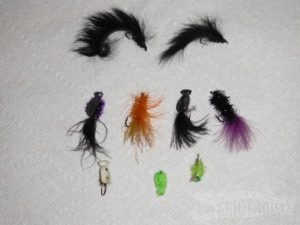
Flies aren’t just for fly rods. Fur and feathers work off Pyramid shore. It’s not for nothing that Pyramid is one of the top fly fishing destination in the US. Flies can not only imitate forage fish but other edible goodies that inhabit the lake. Popular patterns are beetles, Woolly Buggers, Woolly Worms, streamers, and nymphs. Flies can be fished with a sliding or banana sinker and crept along the bottom. Buggers and streamers behind a small weight can be jigged either deep or shallow. Nymphs and buggers can be fished below a bobber letting the wind waves provide the action.
Don’t be afraid to mix things up. When using a larger jig or spoon you can tie a smaller jig or fly on a dropper. Two jigs or flies in tandem can get extra hits.
Where to fish: With nearly 70 miles of shore and little impediment to access. Currently most of the East shore is off limits from shore but there remain lots of fishing opportunity. You can access many different fishing environments. Sandy bottoms, rocky bottoms, Tufa towers. Shallow shelves where wading and ladders are indicated to sharp shoreline dropoffs where you can stand in the sand and cast into 60 feet or more of water. There are spots that are popular with anglers where you will usually find fellow fishermen and other places where you can walk for hours and fish in solitude.
Some fishing spots

Spider Point. Spider Point is 4.5 miles north of the town of Sutcliffe. There is a deep drop off around the point with a bottom of sand and pebbles. Spoons, jigs, hard plastic and flies all work here.

Pelican Point. Pelican is 3 miles north of Sutcliffe. Pelican north of the boat ramp is a shallow sandy shelf. Here waders will be needed. Fishing here is best in the spring when the trout are looking for a place to spawn. All techniques work here. South of the ramp are tufa rocks. Here you need to keep your offering off the bottom to avoid snags.

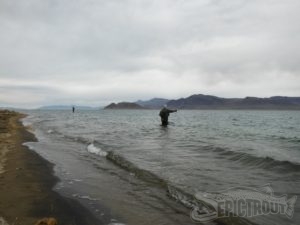
Wino Beach. Wino is 6 miles south of Sutcliffe. It a sandy area with a sand bottom. Deeper water can be reached from shore but waders are recommended. Jigs, Spoons and flies are the mainstay here.
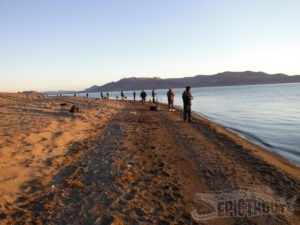
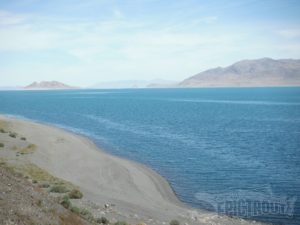
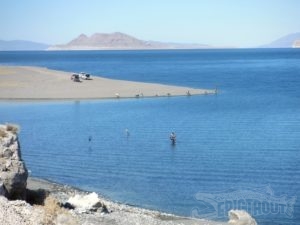
Popcorn. This spot is near the south end of the lake is 11.5 miles south of Sutcliffe. The area has flats and some moderate dropoffs. The bottom is mostly sandy with a few areas of tufa. Jigs, flies, spoons and hard plastics all work here.
These are just a few of the named spots and there are many more that are un named. Use your imagination, 4WD and your feet to find them.
One last thing to consider bringing on your trip to Pyramid is a camera. Pyramid is an ever changing panorama of lake, stark desert mountains and sky. You will also want a picture of your beautiful desert trout.
The heart of the Pyramid experience is Crosby’s Lodge in Sutcliffe. Here you can get your fishing equipment and permits. Arrange lodging, have a meal or a beer and spread myth with fellow fishermen. Crosby’s is on line at:
